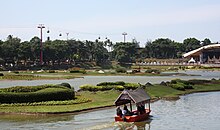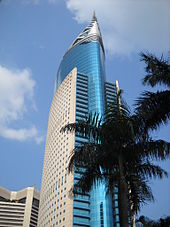Most of the visitors attracted to Jakarta are domestic tourists from all over Indonesia. As the gateway of Indonesia, Jakarta often serves as the stop-over for foreign visitors on their way to Indonesian popular tourist destinations such as Bali and Yogyakarta. Other than attracted to monuments, landmarks, and museums around Merdeka square and Jakarta Old Town, tourist attractions include Taman Mini Indonesia Indah, Ragunan Zoo, Sunda Kelapa old port and the Ancol Dreamland complex on Jakarta Bay, including Dunia Fantasi (Fantasy World) theme park, Sea World, Atlantis Water Adventure, and Gelanggang Samudra.
Tourism is contributing a growing amount of income to the city. In 2012, the tourism sector contributed 2.6 trillion rupiah (US$268.5 million) to the city's total direct income of 17.83 trillion rupiah, a 17.9 per cent increase over 2011. Tourism stakeholders are expecting greater marketing of the Jakarta as a tourism destination.[127]
Since February 2014, the Jakarta Government provides free double-decker bus tours that offers sightseeing in Central Jakarta. The buses' route covers tourist attractions, such as Monas, Istiqlal Mosque, the Cathedral, National Museum, Sarinah, and Plaza Indonesia, as well as Grand Indonesia shopping centres.[128][129]
Landmarks[edit]
Most of Jakarta's landmarks, monuments and statues were built during the Sukarno era beginning in the 1960s, then completed in the Suharto era, while some originated in the colonial Dutch East Indies period. The most famous Jakarta's landmark that become the symbol of the city is the 132 m (433 ft) tall obelisk of National Monument (Monumen Nasional or Monas) right in the centre of Merdeka Square, Jakarta's Central Park. On its southwest corner stands a Mahabharata themed Arjuna Wijaya chariot statue and fountain. Further south through Jalan Thamrin, the main avenue of Jakarta, the Selamat Datang monument stands on the fountain in the centre of Hotel Indonesia roundabout. Other landmarks include the Istiqlal Mosque, the Jakarta Cathedral and Immanuel Church. The former Batavia Stadhuis in Jakarta Old Town is also the city's landmark. The Wisma 46 building in Central Jakarta is currently the second tallest building in Indonesia.
Some of statues and monuments in Jakarta are nationalist, such as the West Irian Liberation monument and Dirgantara statue. SeveralIndonesian national heroes are commemorated in statues, such as Diponegoro and Kartini statues in Merdeka Square, Sudirman andThamrin statues located in each respectable avenues, also Sukarno and Hatta statues in Proclamation Monument also on the entrance of Soekarno–Hatta International Airport.
Parks[edit]
In June 2011, Jakarta had only 10.5% green open space (Ruang Terbuka Hijau) and will be added to 13.94% public green open space. Public parks are included in public green open space. By 2030, the administration also hope there are 16% private green open space.[130]
- Merdeka Square (Medan Merdeka) is an almost 1 km2 field housing the symbol of Jakarta, Monas or Monumen Nasional (National Monument). The square was created by Dutch Governor-General Herman Willem Daendels (1810) and was originally named Koningsplein (King's Square). On 10 January 1993, President Soeharto started the beautification of the square. Several features include a deer park and 33 trees that represent the 33 provinces of Indonesia.[131]
- Lapangan Banteng (Buffalo Field) is located in Central Jakarta near the Istiqlal Mosque, Jakarta, Jakarta Cathedral, and the Jakarta Central Post Office. It is about 4.5 hectares. Initially it was called Waterlooplein and functioned as the ceremonial square during theNetherlands East Indies colonial period. A number of colonial monuments and memorials erected on the square during the colonial period were demolished during the Sukarno era. The most notable monument in the square is the Monumen Pembebasan Irian Barat (Monument of the Liberation of West Irian). During the 1970s and 1980s the park was used as a bus terminal. In 1993 the park was turned into a public space again. It has become a recreation place for people and is occasionally also used as an exhibition place or for other events.[132] The Jakarta Flona (Flora dan Fauna), the flower and decoration plants and pet exhibition, is held in this park around August annually.
- Taman Mini Indonesia Indah (Miniature Park of Indonesia), in East Jakarta, has 10 mini parks.
- Suropati Park (Taman Suropati) is located in Menteng, Central Jakarta. The park is surrounded by several Dutch colonial buildings. Taman Suropati was known as Burgemeester Bisschopplein during the Dutch colonial time. The park is circular shaped with a surface area of 16,322 m2. There are several modern statues in the park made by artists of the ASEAN countries, which contributes to the nickname of the park "Taman persahabatan seniman ASEAN" ("Park of the ASEAN artists friendship").[133]
- Also located in Menteng are Menteng Park (Taman Menteng) and the Situ Lembang pond. Menteng Park was built on the site of the former Persija football stadium.
Sports[edit]
Jakarta was host of the 1962 Asian Games[134] and will host the upcoming 2018 Asian Games, co-hosted by Palembang.[135] Jakarta also hosted the regional-scale Southeast Asian Games in 1979, 1987, 1997, and 2011 where it serves as supporting city for Palembang.Gelora Bung Karno Stadium, located in Central Jakarta, hosted the group stage, quarterfinal and final of 2007 AFC Asian Cup along with Malaysia, Thailand and Vietnam.[136]
Jakarta's most popular home football club is Persija, which plays its matches in their home stadium at Bung Karno Stadium. The home match of Persija often draws its large fanbase - The Jak, usually clad in Persija's typical orange kit – to watch the match in the main stadium. The large number of spectators flocking to the main stadium usually worsen the traffic congestion in Jakarta. Another football team in Jakarta is Persitara who compete in Liga Indonesia Premier Division and play its games in Kamal Muara Stadium. Kamal, North Jakarta.
The biggest stadium in Jakarta is Gelora Bung Karno Stadium, with a capacity of 88,083 seats.[137] The Senayan sports complex has several sport venues, including the Bung Karno football stadium, Madya Stadium, Istora Senayan, aquatic arena, baseball field, basketball court, badminton court, a shooting range, several indoor and outdoor tennis court and a golf driving range. The Senayan complex was built in 1959 to accommodate the Asian Games in 1962. For basketball, the Kelapa Gading Sport Mall in Kelapa Gading, North Jakarta, with a capacity of 7,000 seats, is the home arena of the Indonesian national basketball team.
The Jakarta Car-free Days are held weekly on Sunday on the main avenues of the city, Jalan Sudirman and Jalan Thamrin, from 6 am to 11 am. The briefer Car-Free Day which lasts from only 6 am to 9 am is held on every other Sunday. The event invites local pedestrians to do sports and exercise and have their activities on the streets that are normally full of cars and traffic. Along the road from the Senayan traffic circle on Jalan Sudirman, South Jakarta, to the "Selamat Datang" Monument at the Hotel Indonesia traffic circle on Jalan Thamrin, all the way north to the National Monument in Central Jakarta, cars are cleared out for pedestrians. Morning gymnastics, calisthenics and aerobic exercises, futsalgames, jogging, bicycling, skateboarding, badminton, karate, on-street library, and musical performances take over the roads and the main parks in Jakarta.[138]
Jakarta Marathon is said to be the "biggest running event of Indonesia". It is recognised by AIMS and IAAF. First established in 2013 to promote Jakarta as sports tourism city. In 2015 edition of marathon, more than 15,000 runners from 53 countries were participated.[139][140][141][142][143]












